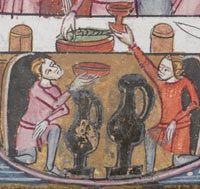 |
 |
 |
 |
 |
 |
 |
 The evidence: account books The evidence: account books
(6/6) Their hospitality was so great that if either
the king, bishops or any
The fifteenth-century account books for Fountains Abbey certainly suggest that the abbot, who was at this time a man of prominence within the locality and the kingdom at large, entertained noble guests as lavishly as any great lay lord. Abbot Greenwell (1442-71) and whoever joined him at table, feasted on figs, walnuts, pears, fish and oysters, as well partridges, quails and venison.(20) Greenwell’s successors evidently dined just as finely, for excavations in the nineteenth century uncovered a hoard of bones and shells – beef, mutton, pork and venison bones, oyster, mussel and cockle shells.(21) Guests were probably also entertained to minstrels, players and fools. The Bursar’s Account Book of Fountains includes payment to minstrels, players from Thirsk and Ripon, a fool from Byland and ‘a strange fabulist.’(22) Even Sawley, one of the poorest of the Yorkshire Cistercian houses, spent 27s 4d on minstrels in the late fourteenth century.(23) By the time of the Dissolution, Roger Aske, a leading figure in the Pilgrimage of Grace who argued against the closure of the monasteries, paid tribute to their valuable contribution to hospitality. Aske maintained that hospitality had disappeared with the monasteries, since the monks alone could afford shelter and refuge to pilgrims, corn dealers and travellers in the remote and barren parts of the North.(24) |
||||
